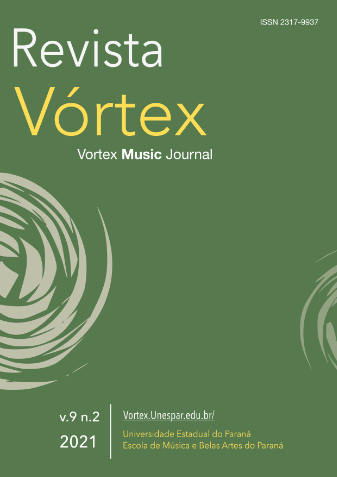Making Complex Music with Simple Algorithms, is it Even Possible?
DOI:
https://doi.org/10.33871/23179937.2021.9.2.3Keywords:
Algorithmic composition, Computational complexity, Dynamic systems, Acoustic processingAbstract
Algorithmic composition is often limited to score generation, but may also include sound production. All levels from sound synthesis to the generation of a complete composition can be integrated into one monolithic program. A strict separation of the low level of sound synthesis and higher levels otherwise reserved for algorithmic composition is not necessary, information can flow between all levels. An interesting challenge in this kind of thorough algorithmic composition is to generate as complex music as possible with as little code as possible. The challenge has been accepted, successfully or not, in a series of compositions called Kolmogorov Variations. We discuss the techniques used in a few of the pieces as well as the promises and perils of this strict approach to algorithmic composition.Downloads
References
BAYLES, David and ORLAND, Ted. Art & Fear. Observations on the perils (and rewards) of artmaking. Santa Cruz: The Image Continuum, 1993.
HAKEN, Hermann. Synergetics. Introduction and Advanced Topics. Berlin, Heidelberg: Springer, 2004.
HEINICH, Nathalie. Le paradigme de l"™art contemporain. Structures d"™une révolution artistique. Éditions Gallimard, 2014.
HOLOPAINEN, Risto. Self-organised Sound with Autonomous Instruments. Aesthetics and experiments. Doctoral thesis, University of Oslo, 2012.
LOY, Gareth. Musimathics. The mathematical foundations of music, Vol 1. Cambridge, Massachusetts: The MIT Press, 2006.
MAUCH, Matthias and LEVY, Mark. Structural Change on Multiple Time Scales as a Correlate of Musical Complexity. Proc. of the 12th International Society for Music Information Retrieval (ISMIR 2011). Miami, USA, pp. 489-494, 2011.
MEADOWS, Donella. Thinking in Systems. A primer. White River Junction, Vermont: Chelsea Green Publishing, 2008.
NIERHAUS, Gerhard. Algorithmic Composition. Paradigms of Automated Music Generation. Wien, New York: Springer, 2010.
SCHNEIER, Bruce. Applied Cryptography, Second Edition: Protocols, algorithms, and source code in C. New York: Wiley, 1996.
SIEDENBURG, Kai. & McADAMS, Stephen. Four Distinctions for the Auditory "Wastebasket" of Timbre. Front. Psychol. 8:1747, 2017.
SPROTT, Julien C. Elegant Chaos. Algebraically Simple Chaotic Flows. World Scientific, 2010.
Downloads
Published
How to Cite
Issue
Section
License
Copyright (c) 2021 Risto Holopainen

This work is licensed under a Creative Commons Attribution 4.0 International License.
Autores mantêm os direitos autorais e concedem à revista o direito de primeira publicação, com o trabalho simultaneamente licenciado sob a Licença Creative Commons Attribution que permite o compartilhamento do trabalho com reconhecimento da autoria e publicação inicial nesta revista.






